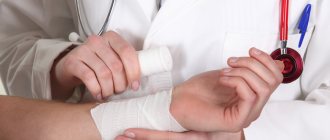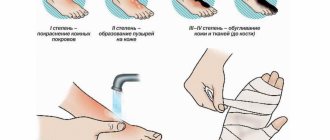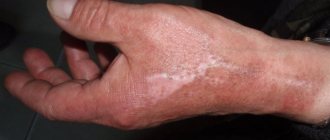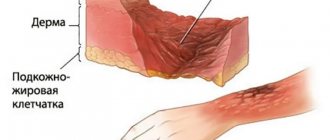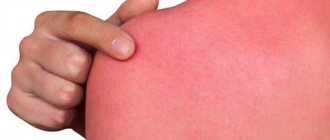Grade I
The burn affects the superficial layers of the skin. The damage is accompanied by redness, slight swelling, severe or moderate pain, and a local increase in temperature. There may also be discomfort when moving. For example, if your hand or fingers are injured, the pain intensifies when you try to move them or when you touch the burned area. With simple treatment, first-degree burns disappear without traces within 2–3 days in adults and 3–5 days in children.
Grade II
The deeper layers of the skin are affected and blisters filled with fluid form. Inflammation occurs around them, and when the bubble is removed, weeping wounds of varying sizes may appear in its place. Grade II injuries are accompanied by swelling and redness. With such a burn, a person experiences burning pain, which for some time can interfere with sleep and leading a normal lifestyle. As the blister heals, it falls off and a crust forms at the site of the wound.
Grade III A
The skin is damaged very deeply; a so-called scab forms at the burn site - a dense gray-brown crust. The painful sensation before its formation is acute, since the damage affects the layers of skin with nerve endings. Sensitivity is reduced, regeneration is very slow, and skin grafting is often required. The risk of developing burn disease increases.
Grade III B
Irreversible damage affects not only the skin, but also the subcutaneous tissue.
Grade IV
An extremely severe burn with charring of the skin and underlying tissues, muscles and bones are damaged.
The degree of burn cannot be the only guideline when providing first aid and planning further actions. For example, with grade I injuries that seem mild at first glance, but with a large area of damage, a burn disease may develop, which cannot be treated independently. This condition is characterized by disruption of the activity of internal organs and all body systems. For severe and extensive burns, treatment and care should be carried out only under medical supervision.
First aid for burns
Let's look at the rules of first aid for minor household burns.
First degree thermal burn of a small area - burn of a finger, hand, etc.
- Immediately stop exposure to high temperature;
- If you are burned by boiling water, steam or a hot object, wash the affected area of the skin with cool boiled water to reduce the pain;
- We apply a combined agent (disinfectant and wound healing).
Thermal burn II degree
- Stop exposure to high temperatures;
- We apply a combined agent (disinfectant and wound healing);
- Apply a sterile bandage. It should be changed daily to prevent infection.
Skin burn with vinegar essence
- We wash the wound with clean running water;
- To neutralize the effect of vinegar essence, apply a solution of soda, soap or ash. They are all alkalis, an antidote to acid;
- We use a product with a healing and analgesic effect openly or under a sterile bandage.
If the vinegar burn affects the eyes, call an ambulance; In this case, you cannot use “neutralizers” yourself.
Iodine burn
- We wash the area of skin that received iodine with running cool water;
- We use toothpaste, crushed chalk, tooth powder, sugar or soap solution as a “neutralizer”;
- If necessary, we apply healing preparations.
Treatment of burns with iodine can be carried out at home, since the damage is most often first degree. But if signs of allergy appear or the damage has spread over a large area, you need to consult a doctor.
Minor electric burn (1st degree)
- Stopping exposure to electricity. The person providing assistance to the victim must be safe.
- We treat the skin with an antiseptic;
- Apply wound healing cream.
Even if the burn caused a small mark on the skin, you should definitely see a doctor. If the injury occurred due to high voltage current, and the resulting damage is extensive and deep, it is necessary to call emergency medical assistance.
Hogweed burn5
- We blot the area where the plant juice has come into contact with a cloth, without smearing the juice on the skin;
- We protect the affected area from the sun and, if possible, go indoors;
- Wash with a solution of soap and soda;
- Treat with an antiseptic;
- We apply a wound healing agent.
In the future, a hogweed burn may require treatment with special means and observation by an allergist.
Jellyfish Burn6
- We immediately leave the sea water;
- If the jellyfish or its fragments remain on the body, remove them from the skin, protecting your hands with gloves or at least a towel;
- We wash the burn site with an antiseptic; you can use alcohol-containing solutions;
- If possible, make a lotion with a cotton swab dipped in soda solution;
- If blisters appear, apply a clean, damp bandage and go to a medical facility.
Ointment for jellyfish burns should only be prescribed by a doctor. Even if the injury is mild, special treatment for a jellyfish sting may be needed to avoid complications.
If a burn of any kind affects a large area of skin, mucous membranes, eyes and respiratory tract, as well as if the injury is severe or a child is injured, urgent medical attention is needed.
What should not be done for burns?
Some traditional methods of treating burns can be harmful. For example, it is strictly forbidden to use oils, as they retain heat on the surface of the skin, thereby aggravating the burn. There is also no evidence that raw eggs help with burns; on the contrary, it can cause infection of the burn surface. Many people believe that it is better to use ice rather than cool water to help with a burn. However, ice can do more harm than good and further irritate burned skin. In some extreme cases, a person may experience a cold burn from exposure to ice. There is also an opinion among ordinary people that using toothpaste at the site of the burn can help cope with the problem. In fact, non-sterile toothpaste can cause the spread of bacteria in the affected area.
What not to do in case of a burn
- When treating a burn with a blister, for example on a finger or hand, it is not advisable to open the blister at home - it is better to see a doctor to make a puncture and remove the membrane. A weeping wound may open under it, into which pathogenic bacteria can easily enter, causing inflammation and other complications.
- Do not touch damaged skin with dirty hands, even if the burn is first degree. Before applying a wound healing agent or when changing a bandage, your hands should be washed and treated with an antiseptic.
- Do not apply ice, cold metal or use ice water to the injury site, so as not to cause additional frostbite to the affected area. Such actions may provide temporary and short-term relief, but then the pain will only intensify. To relieve discomfort, you can wash the burned skin with clean, cool, but not too cold water.
- You cannot provide first aid without taking care of your own safety. This rule is especially important if a person needs help with an electrical or chemical burn.
- Contrary to the widespread “folk” tradition, you should not lubricate the damaged area with oil or fat-containing preparations - they can increase the severity of the damage due to the fact that they create a “film” on the damaged area.
- It is not recommended to use substances containing alcohol for antiseptic treatment - they can cause additional burns, increase pain, dry out already damaged skin, impairing regeneration.
Dexpanthenol in cosmetology
Unfortunately, people often stop appreciating the familiar and treat the most effective substances mediocrely, as if they were for granted. So you won’t surprise anyone with chamomile or aloe vera extract. But it’s not for nothing that they became so popular. D-panthenol (provitamin B3) also falls into the category of ubiquitous components. And not in vain either.
It is intended for the care of dry skin prone to flaking and irritation, including aging skin or skin that is exposed to chapping. It prevents tightness, itching, moisturizes the skin, penetrating into the deep layers. Participates in biosynthesis, smoothes wrinkles. Instantly heals wounds, prevents injured skin from healing and changing color.
D-panthenol is also used for dry, damaged hair. It envelops the hair with an elastic film, making it resistant to environmental influences, be it sun, wind, frost or dry air. In addition, it is advisable to use it in hair masks and conditioners that are applied for a long time. By the way, that same magical Pro-V formula that Pantene is proud of includes Panthenol. Actually, this is clear from the name: Pantene Pro-V - Panthenol Provitamin.
It is very useful to add a high concentration of D-panthenol to lip glosses and balms; it will help prevent your lips from drying out and make them healthy. Unless you don't mind its bitter taste. Panthenol is also added to the cream for hands, nails, elbows and heels. The excellent softening abilities of D-panthenol increase significantly when paired with allatonin.
When preparing homemade cosmetics, it should be taken into account that heating panthenol to 50°C deprives it of all properties. That is why there is no point in adding it to solid soap.
Which doctor should I contact if I get a burn?
If you have a mild first-degree skin burn, you can contact a physician at the clinic. If the injuries are grade II, help can be provided by a surgeon or emergency room doctor.
Doctors who treat third- and fourth-degree burns are combustiologists. “Severe” victims, patients with burn disease and other complications are referred to them. It is extremely difficult to find a combustiologist in a district clinic; as a rule, doctors of this profile work in large or specialized medical institutions.
Dexpanthenol for skin damage
Treatment of burns is far from the only indication for use. The amazing regenerating, metabolic and some anti-inflammatory properties of dexpanthenol will be useful in the healing of postoperative scars and aseptic wounds, bedsores, boils, trophic ulcers, skin lesions after herpes rashes and in general for any skin damage. They will help babies cope with diaper rash and diaper dermatitis, and their mothers with cracked nipples. Dexpanthenol will also help with eye diseases, such as corneal erosion, eye burns, keratitis, and corneal dystrophy.
In general, it is better not to remove D-panthenol far away. Especially if there is a child in the family. Unfortunately, for many, abrasions, scratches, cuts and irritations are far from uncommon. Such a miracle remedy can come in handy suddenly and urgently.
Treatment of burns
General treatment of household burns is aimed at:
- Protection against infection;
- Maintaining normal regeneration;
- Eliminate discomfort.
Local treatment of minor (1st degree) burns can be done at home using good over-the-counter topical medications.
When treating second degree thermal burns when blisters appear, the following methods are used:
- Open With the open method, thanks to the constant flow of fresh air, the burned skin dries naturally and heals easily. The disadvantage of this method is a higher risk of infection. Additionally, touching, rubbing, or any other mechanical force on the damaged area can slow down recovery and cause discomfort.
- Closed In the closed method, moisture-absorbing sterile dressings with a healing agent are applied to the burn site, for example when treating blisters. They absorb fluid discharged from wounds and protect against secondary injury and infections. The bandage must be changed regularly. The closed method of treating burns is often used when the skin on a moving part of the body or in contact with clothing is damaged. The disadvantages of the closed method are possible painful dressings and relatively high consumption of materials7.
- Mixed Open and closed methods can be used simultaneously, alternating throughout the entire treatment period. The open method is chosen when the victim can be at rest and the burn wound will not be subject to mechanical stress (touching, friction of clothing, stretching). Applying a bandage will protect the wound from infection and unnecessary irritation, for example, if a person needs to actively move.
To treat inflammation during a burn, which can occur as a complication, antibacterial drugs and additional treatment of the burned area of skin are sometimes prescribed. At the healing stage, you need to reduce the mechanical impact on the affected area - this way recovery will take less time, and the wound will heal without leaving any traces. During this period, it is advisable to use special products that support regeneration and have an antiseptic effect, for example, Bepanten Plus cream.
"Bepanten Plus" for healing skin burns
Domestic burns can be treated at home using wound healing agents. These include Bepanten Plus cream, intended for minor skin damage8. Chlorhexidine in its composition kills bacteria and prevents infection, thereby reducing the risk of inflammation and complications. Provitamin B5, also contained in the cream, promotes natural skin restoration.
In addition, an important feature of Bepanten Plus is its cooling effect, due to which the pain subsides and the person feels better. Thanks to this, Bepanten Plus Cream will become an indispensable assistant for the mother of a baby or teenager.
The cream with a light texture is easily absorbed and does not stain hands or clothes. It is suitable for application under a bandage or openly. This product is indispensable for a home, travel or children's first aid kit, since Bepanten Plus can be used by both adults and children to restore skin, protect and speed up recovery from a mild household burn.




